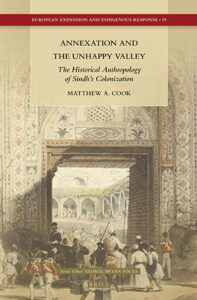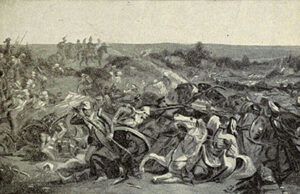
Author: Mathew A. Cook
Publisher: OUP Pakistan, 2021
Pages: 312
Price: Rs. 995

Culture is the élan vital that gives meaning and context to all human action and interaction. It is more than just what we call “the culture of the people,” but rather a complex interaction among people that forms the basis of society and the state, among others. In essence, it is the beliefs, norms, and symbols that form the basis of humanity as a whole. In recent years, anthropology has been an increasingly important field due to the increasing transmission of culture across generations and the influence of globalisation in shaping cultural patterns.
In his book Annexation and the Unhappy Valley, Mathew Cook attempts to bridge metropole-colony divisions and foster a sense of interconnectedness — “connected histories” — something occurring in South Asia and the empire, transcending disciplinary boundaries.
Mathew Cook’s historical, anthropological study directly helps develop new strands in current imperial history writing by facilitating the interaction of “Empire historians” and “historians of colonial rule.” Its multidisciplinary approach enables a fine-grained, nuanced, and firmly situated analysis of what was, in fact, many players and diverse points of view involved in the same “event.” Emphasising the added advantage of adopting a socio-cultural approach to historical knowledge.
Historical anthropology is the study of historical societies, using social and cultural anthropological techniques and objectives. Historical anthropology is not synonymous with social history. It places a premium on qualitative research over quantitative, small groups, and symbolic aspects of culture.
Annexation and the Unhappy Valley examines the British empire’s geographical and political growth and consolidation in South Asia. It blends anthropology with history, using a sophisticated, contextualised interpretation of various actors and their actions. The book explores how the political and administrative annexation of the land influences the transformation of intra-cultural differences into socio-historical conflicts. This project examines “direct” colonial control in South Asia rather than indirect colonial rule. It explores how differences in actors, views, and intents affect the behaviours and architecture of colonial administration — both within and between areas.
The written records of numerous European travellers who visited India as missionaries, traders, envoys, spies, and adventurers provide an excellent source of Sindh’s society and culture before the British annexation of Sindh in 1843. Manrique, a prominent missionary who visited Sindh to restore a church in Thatta, was one of the first missionary travellers. Christian missionaries were present in Sindh, according to his testimony. He met with Father Jorge de la Natividad, the mission’s superior. He showed him the Farman [proclamation] he received from Asaf Khan [d.1641] for the church’s maintenance. Later, the church was rebuilt under the supervision of the ruler of Thatta.
Alexander Hamilton (1688-1723), another earlier visitor to Sindh, wrote in his book, A New Account of the East Indies, published in London in 1744, on the fertility of Sindh’s soil and agricultural practices:
“This country abounds richly in wheat, rice and legume, and provender for horses and cattle; and they never know the misery of famine, for the Indus overflows all the low grounds in the months of April, May and June, and when the floods go off, they leave a fat slime on the face of the ground which they till easily before it dries and being sown and ban-owed, never fails of bringing forth a plentiful crop.”
Several historical studies of Sindh conclude their examination at the time of annexation. In contrast, Annexation and the Unhappy Valley begins in 1843. Cook explores the 1843 British annexation of Sindh to shed light on the historical nature of one such annexation and to acquire a better understanding of its socio-cultural implications. Additionally, most analyses of annexations presuppose an isomorphism between what happens in a particular location and its socio-historical interpretation. Cook adopts an interesting multi-sited approach, analysing annexation via the physically “disconnected” — Sindh, Bombay, Calcutta, and London — which he argues are culturally linked.
Annexation and the Unhappy Valley situate South Asia within a broader imperial system that circulates commodities, money, people, politics, and cultural ideas. It crosses borders to establish new historical connections while adhering to fine-grained assessments of “local” differences in various places. It demonstrates how muddying one’s feet in the socio-cultural (rather than simply political-economic) bogs of multi-site research may create linked forms of history. By severing the connection between annexation and its cultural and historical interpretation, Cook dislodges contextually significant histories and social debates from traditionally disregarded locales. It attempts to align historical anthropology of colonialism with current social science methods that avoid a false dichotomy between local and global levels of study.

Four chapters constitute Annexation and the Unhappy Valley. The first, ‘Merchants and the East India Company in Sindh,’ examines support for the Company and its relationship to sociocultural distinctions within one key community of local collaborators, Bhaiband merchants, who used their relationship with the British to undermine the internal dynamics of the larger Lohana community to which they belonged. Chapter 2, ‘Conspiracy and Military-Fiscalism,’ continues the theme of identifying distinctions within groups, but this time deconstructs and then reconstructs the multi-sided debate that raged among the British (both in India and in London) in the early 1840s over the “ways and means” of annexing Sindh. Chapter 3, ‘Just Governance and Colonial Violence,’ then elucidates the conflicts between concepts of “just governance” and “colonial violence” as they manifested in the aftermath of Sindh’s annexation. This highlights the inconsistencies between what an organisation such as the Company professed to accomplish in principle and what it really performed in reality. Finally, Chapter 4, ‘Court over Board,’ traces disjunctions between power-holders in the United Kingdom and South Asia with the goal of challenging dominant constitutional perspectives that, according to Cook, underestimate the extent to which the Board of Control has control over Company actions in the field. As Cook’s research demonstrates, during a time of British territorial expansion on the subcontinent, significant differences of opinion divided, and therefore complicated, British objectives. Apart from that, the Company often provided the Board of Control in London with a fait accompli in terms of acts done, weakening its power in reality.
As is the case with most research, Annexation and The UnhappyValley shows both the strengths and the shortcomings. On the positive side, it exposes the reader to a narrative that is still relatively unknown or little understood, albeit one could argue that it qualifies as a “post-annexation vacuum.” Cook is diligent in his search for official and unofficial archive material gathered in London, Maharashtra and Sindh. By combining official records with handwritten comments, notes, and other sources, he illuminates a wealth of fascinating discursive material and attendant discussion that are all connected in some way to an “infamous” event in the development of British authority in South Asia. This was Sindh’s military annexation in 1843 and the repercussions, which are probably best known outside scholarly circles due to the misattribution of the term “peccavi” or “I have sinned/Sindh” to the British commander responsible, Charles Napier. This pun was created not by Napier, but by the newly launched funny magazine Punch. However, its usage reflected the degree of contemporaneous condemnation of Napier’s conduct, with opponents accusing him of treating Sindh’s local rulers, or Amirs, unjustly. Few historians have written on these changes, and no historical anthropologists have tried to work on them with such fidelity to their sources. It is, however, somewhat perplexing that neither the Introduction nor Chapter 2 make any reference to H. T. Lambrick’s 1952 study, which pioneered awareness of the controversies surrounding why annexation occurred, Charles Napier’s role in, and the divided response to British actions in India and back in London. Certainly, Annexation and the Unhappy Valley offers a welcome and long-overdue concentrated attempt to examine and debate with forensic rigour the “anatomy” of Sindh’s annexation’s aftermath in the years, if not decades, that followed.

Editor, Narratives



